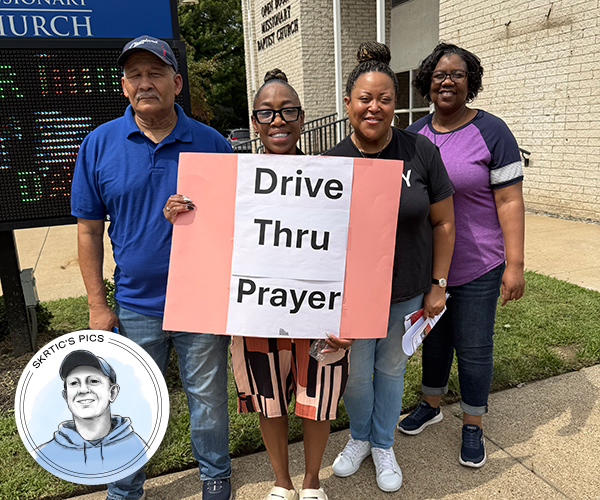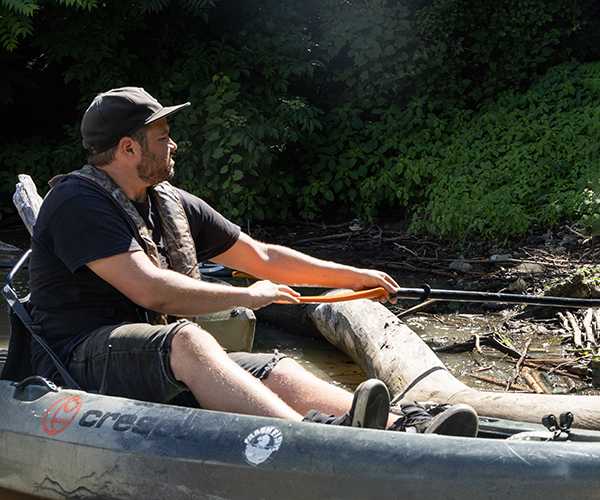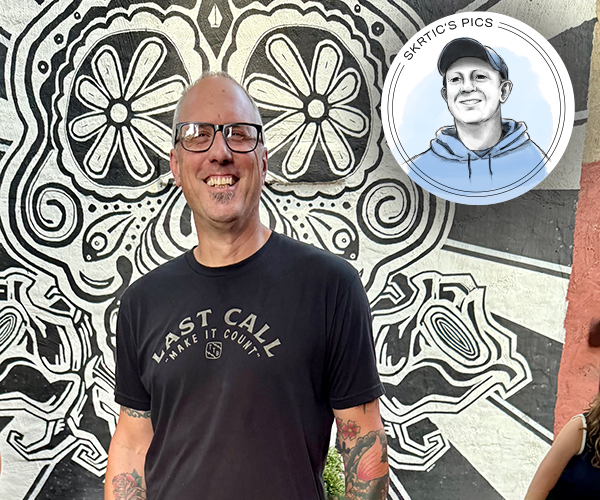Nineteen years ago, Brian Michael Bendis was eking out a mild-mannered existence as a Super City Comics clerk on the second floor of the Old Arcade. A week before Thanksgiving 1992, it was also where he witnessed the death of
Superman.
The mob of mourners stretched from the register, past the racks of X-Men and Batman comics, through the trading card room, out the door and down to Euclid Avenue. Fans, collectors and rubber-neckers alike waited patiently in the November air. They didn't mind the lake's chilly breath if it meant they'd take home the new issue of Superman and its 22 full-page panels that depicted the Man of Steel and a brainless alien beast beating the life out of each other. Bendis still remembers the anticipation on the customers' faces.
"Anybody who wants to do this for a living needs to get behind the counter and see how audiences react," says Bendis, who grabbed the industry's attention with his own creations before spending the past 11 years crafting storylines for iconic Marvel heroes such a Spider-Man, Daredevil and the Avengers.
He's a consultant for The Avengers, the movie filming here this summer, and is also working on the pilot for his police procedural, Powers. Based on the comic Bendis created in 2000, the show is being filmed in Chicago and could end up on the FX cable channel this winter.
But first things first. By the time you read this, Peter Parker may well be dead and buried. For the past couple months Bendis has been unspooling a world-changing story arc for the Ultimate Spider-Man title he has written since its 2000 launch. It's called "Death of Spider-Man," and at press time, issue No. 158 found Peter Parker nursing a nasty bullet wound and facing down a band of his most fearsome enemies.
The final moments come in issue No. 160 (released June 22), and when we talked to Bendis in May, it was clear writing the installment stirred some heavy emotions in him. Maybe it's because he and Peter Parker have been friends for so long.
"By age 6, I made an early proclamation that I was dedicating my life to writing and drawing Spider-Man," Bendis recalls. The skinny kid from University Heights spent every dime he had on the art form popularized by Superman creators Jerry Siegel and Joe Shuster, who had grown up five miles away in Glenville.
Bendis never outgrew his superhero phase, working the patience of faculty at the Hebrew Academy of Cleveland during his teen years. "I was annoying the crap out of my rabbis and teachers with my constant doodling of Spider-Man, Captain America and the Punisher," he says.
Following high school, he enrolled at the Cleveland Insitute of Art. A year later, he also got the job at Super City Comics, another place where he spent hour upon hour creating. "I was always drawing behind the counter," Bendis says.
And when he did, his mind drifted beyond Euclid Avenue to the rusting city's more suspect street corners and suspicious lurkers. He merged real people and places with his wild imagination to write and draw an alternative world — a violent caricature of the one he inhabited. He populated his unforgiving city of sleaze with grifters, gangsters and bounty hunters. They talked like real people (mostly Bendis and his friends) and hung out in the dark alleys and all-night diners he passed by on his bus ride to the comic shop.
"Brian was going to make it, no matter what," says Jim Williams, Bendis' former manager at Super City Comics and the current owner of Comic Heaven in Willoughby. "It wasn't cockiness. It wasn't arrogance. It was dedication."
Bendis gained national attention for his 1996 series Jinx. Think of it as The Good, The Bad and The Ugly by way of the Crooked River. He then exhumed a gruesome chunk of Cleveland's history in 1998 with Torso, a fictional account of former safety director Eliot Ness' attempt to catch the Torso Killer.
Jinx and Torso were gritty parables about broken people that helped Bendis get the attention of Marvel Comics, who chose him to bring its Ultimate Spider-Man title to life. The Ultimate titles are an alternate universe of sorts, a way for Marvel to free writers to reinvent iconic characters. Under Bendis' guidance, Spider-Man was reborn, starting with the radioactive spider bite that gave Peter Parker his powers.
Bendis, who now lives in Portland, Ore., says he learned a few things from how readers reacted to Superman's death 19 years ago. Like many fans, he was disappointed by the story. It's something Bendis says he thought about a lot while crafting "Death of Spider-Man."
They're going to sell a million copies of these. It should be the best comic ever made, he recalls thinking about Superman's demise. "I have come to this book with that feeling."
Bendis is confident readers will be more satisfied with "Death of Spider-Man." There will, of course, be one similarity. After a temporary dirt nap, the Man of Steel came back to life. A new Ultimate Spider-Man will emerge this fall, too, Bendis says: "One who will look at the legacy differently and have different powers."
While he's tight-lipped about exactly what that means, there's one thing Bendis, Peter Parker and comic book fans around the world all know: With great power comes great responsibility.
Q & A with Brian Michael Bendis
Q. So, Spider-Man's in a pretty sticky situation, huh?
A. It's the battle of his life. He's maskless, fighting his biggest foes, trying to save his family on his front porch. Each villain symbolizes something different to Peter Parker's character and what he has learned as Spider-Man.
Q. So is he really going to die or what?
A. It's called "Death of Spider-Man," so I don't think we're hiding too much.
Q. Spider-Man was your first creative muse and first commercial success. What was it like writing issue No. 160?
A. It was planned quite a bit ahead of time. I had a good sense of it, but I felt something more could be said. Just before I was about to write it, it hit me what the book was really about. I was writing with tears in my eyes. I was a mess. It's this one last little moment that did it. So I sent it to my editor, kinda embarrassed, and he called me back and said, "I haven't cried like that in a while."
Q. In 2007, director David Fincher was set to direct Ness, a film version of your graphic novel Torso, based on Cleveland's Torso Murders. What happened?
A. After years of development, all of a sudden someone goes, "David Fincher wants to develop it." I go, "He's one of my favorite people on the entire planet." I spend the day with him and he opens a book showing all the locations in Cleveland he has scouted, reproducing all the places I used. He was super into it, and the cast was set. I heard the words "green lit" for the first time, and two days later it falls apart because of some scurfuffle at Paramount, which had nothing to do with the project. He ended up doing The Social Network instead, which I loved so much I wasn't even annoyed. The rights reverted back, and we have two options on the table. It's not dead, but I doubt it will be Fincher.
Q. Moving on to a movie that will be filmed here, tell us about The Avengers.
A. Yeah, I'm a consultant on it. Best job ever, maybe? I'm very excited it's happening there, man. It's an amazing screenplay. And I don't hype frivolously. I think it's the best thing Joss Whedon's ever written. I was in awe of it, and I still am.
Q. And you already brought the Avengers to Cleveland in the comics.
A. The Avengers knock down New York every three days. I needed to get them out of there. I said, "Let's knock over Public Square for a while." These images were always in my head as a kid: Spider-Man swinging by the Terminal Tower. I finally put it on paper. It exists. I should have quit right then.
Q. You write The Avengers and New Avengers every month. What's the underlying theme of this supergroup?
A. What's important is they're getting together to do something they can't do by themselves. There's a certain thing in the world that's so humongous Iron Man can't handle it by himself. Thor can't handle it by himself. As a team, they become this great band of brothers. It's such a lonely experience behind the mask. And no matter what you do for a living, there are certain experiences that only those that do it can possibly understand what you're going through.
Q. What can you say about the movie Captain America: The First Avenger, which comes out this month.
A. I've seen it, and it was great. Red Skull, played by Hugo Weaving, is a really good villain, probably the best from Marvel [Studios].
Q. A friend of yours told me there was a memorable incident on the Lorain-Carnegie Bridge when you were shooting pre-storyboard photos for Jinx. What happened?
A. I made all kinds of mistakes that day. We were shooting the cover of Jinx. John [Skrtic] thought we'd need the props, so I took out the [BB] gun, the machete, handcuffs. ... I guess people saw and called the police. We were surrounded by four cop cars, and all hell broke loose. Guns were fully drawn. It was quite startling. I was thrown in a squad car. They didn't arrest the very attractive girl we were with. They had a nice conversation with her. Then the cop comes over to my car and screams, "You idiot! I was going home tonight, and you were gonna go home in a body bag!" And I go — and this is something I shouldn't have said, I go — "I'm sorry I scared you."



